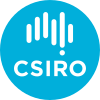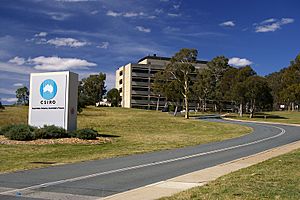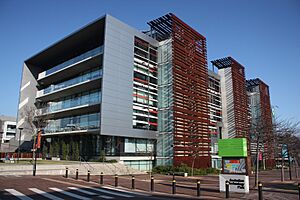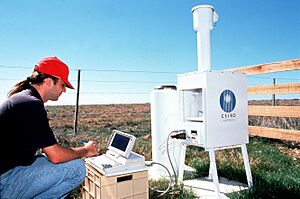CSIRO facts for kids
 |
|
 Former corporate headquarters. |
|
| Agency overview | |
|---|---|
| Formed | 1916 |
| Preceding agencies |
|
| Jurisdiction | Australia |
| Headquarters | Canberra, Australian Capital Territory, Australia |
| Motto | We imagine. We collaborate. We innovate. |
| Employees | 5,565 (2017) |
| Minister responsible |
|
| Agency executives |
|
The Commonwealth Scientific and Industrial Research Organisation (CSIRO) is Australia's national science agency. It's a special part of the Australian Government that does scientific research.
CSIRO works with top organisations all over the world. Its main office is in Canberra, Australia. CSIRO has more than 50 locations across Australia, France, Chile, and the United States. About 5,500 people work there.
Australia started funding scientific research in 1916. An early group, the Advisory Council of Science and Industry, was set up then. But it didn't have enough money. In 1926, a new group called the Council for Scientific and Industrial Research (CSIR) was formed. This group got more funding and helped science grow in Australia. CSIR quickly became successful. In 1949, the group changed its name to CSIRO.
CSIRO has made many important discoveries. These include inventing atomic absorption spectroscopy. They also helped create important parts of early Wi-Fi technology. CSIRO developed the first successful polymer banknote (plastic money). They invented the insect repellent in Aerogard. They also helped control rabbit populations in Australia. They did this by introducing diseases like myxomatosis and rabbit calicivirus.
How CSIRO is Organized
CSIRO is led by a board chosen by the Australian Government. The current leader of the board is Kathryn Fagg. There are eight directors, including the chief executive, Doug Hilton. These people manage the whole organisation.
What CSIRO Researches
CSIRO is set up into different groups. These include Research Business Units, National Facilities and Collections, and Services.
Research Teams

As of 2023, CSIRO's research focuses on "Impact science." This means they work on science that helps people and the planet. Their research teams are:
- Agriculture and Food (studying farming and food)
- Health and Biosecurity (looking at health and preventing diseases)
- Data61 (working with data and digital technology)
- Energy (finding new ways to get power)
- Manufacturing (improving how things are made)
- Mineral Resources (studying minerals and mining)
- Environment (combining studies of land, water, oceans, and atmosphere)
National Facilities and Collections
Big Research Facilities
CSIRO runs special research places and equipment for Australia. These "national facilities" help with research. Scientists from Australia and other countries can use these labs. Some of these facilities are:
- Australian Centre for Disease Preparedness (ACDP) – for studying diseases.
- Australia Telescope National Facility – a group of radio telescopes. These include the Parkes Observatory.
- Canberra Deep Space Communication Complex – for talking to spacecraft in deep space.
- Energy Centre and National Solar Energy Centre – for energy research.
- Marine National Facility (R.V. "Investigator") – a research ship.
- New Norcia ground station – another space communication station.
- NovaSAR-1 satellite – a satellite for Earth observation.
- Pawsey Supercomputing Centre – a very powerful computer centre.
Important Collections
CSIRO also looks after many collections of animals and plants. These collections help us learn more about biology in Australia and worldwide. They are used for research on species, genetics, farming, and ecosystems. Some of CSIRO's collections are:
- Australian National Algae Culture Collection
- The Atlas of Living Australia (a huge database of Australian life)
- Australian Tree Seed Centre
- Australian National Fish Collection
- Australian National Insect Collection
- Australian National Herbarium (a collection of dried plants)
- Australian National Soil Archive (a collection of soil samples)
- Australian National Wildlife Collection
- Cape Grim Air Archive (samples of air from a very clean place)
Services CSIRO Offers
In 2019, CSIRO offered many services. These included:
- Services for materials and buildings.
- Analysis for farming and the environment.
- Services related to the environment.
- Services for biology, food, and medical science.
- Services from the Australian Animal Health Laboratory.
CSIRO also offers education, publishing scientific books, and help for small and medium businesses.
CSIRO's History
How the Organisation Grew
The idea for CSIRO started in 1916. It was called the Advisory Council of Science and Industry. Prime Minister Billy Hughes helped start it. But it didn't have enough money during World War I. In 1920, it was renamed the Commonwealth Institute of Science and Industry. It still struggled financially.
In 1926, the Australian Parliament passed a new law. This law created the Council for Scientific and Industrial Research (CSIR). Prime Minister Stanley Bruce supported it. CSIR grew quickly and had many early successes. It had committees in each state and a main council. CSIR focused on farming and other industries. They started divisions for animal health and nutrition. After the Great Depression, they also started researching manufacturing.
In 1949, the law changed again. The group was renamed the Commonwealth Scientific and Industrial Research Organisation (CSIRO). This change made the organisation bigger. Under Ian Clunies Ross, CSIRO started new areas like radio astronomy. CSIRO still works under the rules of the 1949 law.
For a long time, women faced challenges working in CSIRO research. Until 1966, Australian government rules forced married women to leave their jobs. Even single women were seen as a risk because they might get married. But single women like Helen Alma Newton Turner still made huge contributions.
Since 1949, CSIRO has grown a lot. It now works in almost every industry. This includes the environment, human health, and city planning. It works with top groups worldwide. CSIRO has over 50 sites in Australia and other countries.
Amazing Inventions
CSIRO has made many important inventions and discoveries. Some of these are:
- A4 DSP chip (a type of computer chip)
- Aerogard, a popular insect repellent
- Atomic absorption spectroscopy (a way to analyze materials)
- Biological control of Salvinia (using nature to control a weed)
- Development of Linola (a special flax plant for animal feed)
- Distance measuring equipment (DME) for planes
- Gene shears (a tool for genetic research)
- Interscan Microwave landing system for aircraft
- Using myxomatosis and calicivirus to control rabbit numbers
- Parkes Radio Telescope (a famous telescope)
- The permanent pleat for fabrics (making clothes stay creased)
- Plasma sintering (a way to make materials)
- Polymer banknote (plastic money)
- Production of metals from their halides (a way to make metals)
- Relenza flu drug
- Sirosmelt lance (a tool for metal production)
- "Softly" woollens detergent (for washing wool)
- Phase-contrast X-ray imaging (a new type of X-ray)
- A method to use titanium in 3D printing
- UltraBattery (a special battery)
- Key parts of Wi-Fi technology
- Zebedee - a handheld 3D mapping device
Historic Research
CSIRO played a big part in discovering the universe using radio waves. A team led by Paul Wild built the world's first solar radiospectrograph in 1948. From 1967, they used a huge radioheliograph at Culgoora. For 30 years, CSIRO was a world leader in studying the sun.
CSIRO also owned Australia's first computer, CSIRAC. This project started in 1947. The CSIR Mk 1 ran its first program in 1949. It was the fifth electronic computer in the world. It was over 1,000 times faster than older calculators. It was moved to Melbourne in 1956 and used until 1964. CSIRAC is the only first-generation computer still existing today.
Between 1965 and 1985, George Bornemissza from CSIRO led the Australian Dung Beetle Project. George noticed that cattle dung was not breaking down in Australian pastures. This was because native Australian dung beetles were not used to cattle dung. Cattle were only brought to Australia in the 1880s. So, the project brought in dung beetle species from South Africa and Europe. These beetles helped improve the soil and reduced the number of bush flies by 90%.
Internet Firsts
CSIRO was the first Australian organisation to use the Internet. They were able to get the special internet address `csiro.au`. This was before rules were made in 1996 for how `.au` addresses could be used.
How CSIRO is Run
When CSIR started in 1926, it was led by a small group. Over time, the roles of the chair and chief executive changed. From 1959 to 1986, the chairman did both jobs.
In 1986, the Australian Government changed how CSIRO was run. A board of non-executive members was created. The chief executive now manages the organisation. The board, led by the chair, sets the overall plan and makes sure CSIRO performs well. They report to the Australian Government.
CSIRO's goals and structure have changed as Australia's science needs have changed. Many CSIRO scientists have gone on to lead universities.
Chairs of CSIRO
CSIRO has had many important leaders. Here are some of the people who have chaired the organisation:
- George Julius (1926–1945)
- David Rivett (1946–1949)
- Ian Clunies Ross (1949–1959)
- Fred White (1959–1970)
- Jerry Price (1970–1977)
- Victor Burgmann (1977–1978)
- Paul Wild (1978–1985)
- Norman Boardman (1985–1986)
- Neville Wran (1986–1991)
- Adrienne Clarke (1991–1996)
- Charles Allen (1996–2001)
- Catherine Livingstone (2001–2006)
- Peter Willcox (2007)
- John Stocker (2007–2010)
- Simon McKeon (2010–2015)
- David Thodey (2015–2021)
- Kathryn Fagg (2021–present)
Chief Executives of CSIRO
Here are some of the people who have been Chief Executive of CSIRO:
- David Rivett (1927–1945)
- A. E. V. Richardson (1946–1949)
- Fred White (1949–1956)
- Stewart Bastow (1957–1959)
- (From 1959–1986, the chairman also acted as chief executive)
- Norman Boardman (1986–1990)
- John Stocker (1990–1995)
- Roy Green (1995–1996)
- Malcolm McIntosh (1996–2000)
- Colin Adam (Acting, 2000–2001)
- Geoff Garrett (2001–2008)
- Megan Clark (2009–2014)
- Larry R. Marshall (2015–2023)
- Doug Hilton (2023–present)
See also
 In Spanish: Organización de Investigación Científica e Industrial del Commonwealth para niños
In Spanish: Organización de Investigación Científica e Industrial del Commonwealth para niños
- Australia Telescope National Facility
- Australian Animal Health Laboratory
- Australian Bird and Bat Banding Scheme
- Australian Dung Beetle Project
- Australian Space Research Institute
- Backing Australia's Ability
- Biosecurity in Australia
- Cooperative Research Centres
- Council for Scientific and Industrial Research – Ghana
- Council of Scientific and Industrial Research, India
- Council for Scientific and Industrial Research, South Africa
- CSIRO Oceans and Atmosphere
- CSIRO Publishing
- Defence Science and Technology Group
- Fraunhofer Society, Germany
- George Bornemissza
- Goyder Institute for Water Research, a research collaboration with universities and SA government
- Parkes Observatory
- Peter Rathjen
- SINTEF, Norway
- Susan Wijffels
- Netherlands Organisation for Applied Scientific Research
- Waste management in Australia
- Yingjie Jay Guo


